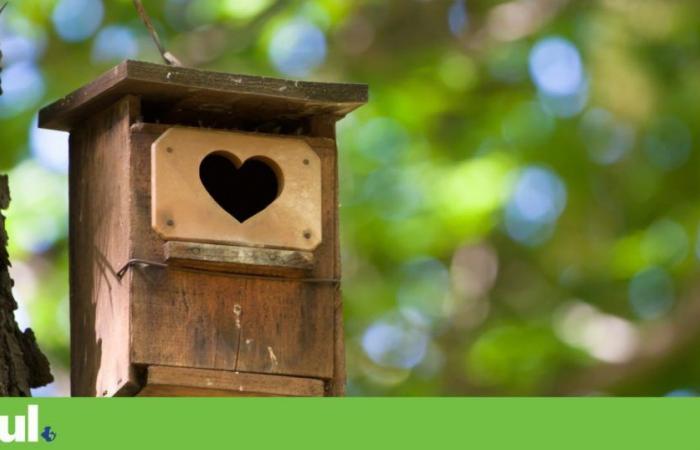I wanted to build a first-class house. Small enough to be cozy, but big enough to raise a family. I needed an ideal location, close to a wooded area, with a natural supermarket nearby. And the design had to be simple, made entirely of wood. Although I was worried about the cost, I didn’t need to be. I just built mine with about $5 worth of materials in one afternoon.
Soon, I hope, my new home will welcome a family of pygmy creepers, small birds with gray wings and a high-pitched call that resembles the squeeze of a rubber ducky.
Humans are known for destroying the habitat of our wild neighbors. But we can be great at creating it. My new bird house is just one example. After decades of studying their birds, ornithologists have designed structures that meet the needs of hundreds of species, from boxes for barn owls to simple baskets for mourning doves, placed on tree branches.
The birds, as you may have heard, are in trouble. Birds in North America have seen a staggering loss of 3 billion breeding adults, or nearly 30% of the population, over the past half century, according to data from the North American Breeding Bird Survey and other wildlife studies.
Humans have removed the large, dead trees from the landscape where cavity-nesting birds make their homes. This has left many birds homeless in habitats that would otherwise be suitable for them. While finding shelter isn’t the only challenge for birds — pesticides, introduced predators, habitat loss and collisions with glass figure prominently — more and better homes can slow losses and help declining populations recover.
“Nest boxes are especially important in habitats where many trees are missing,” says Jack Dumbacher, conservator of ornithology at the California Academy of Sciences. “Most urban and suburban areas could definitely use them.”
But things can go wrong. Poorly designed nest boxes and structures can attract predators, overheat baby birds or encourage overcrowding. This leads to birds ignoring and abandoning potential homes or, even worse, walking into death traps.
Here’s a guide to creating first-class bird housing.
What is a nest box?
Nest boxes or bird houses recreate habitats provided by cavities in dead trees for nesting, roosting and roosting. Not all birds need nest boxes. In North America, only about 85 species, less than half of those that typically live in natural forests, use cavities. But for many, these shelters can be essential to their survival.
Hundreds of other bird species that don’t nest in cavities may still use structures of some kind, from shelves mounted on the side of your home to elevated platforms hundreds of feet high for birds of prey.
An example of the success of bird houses are eastern bluebirds, a species similar to robins, but with blue plumage and a rust-colored throat. By the mid-20th century, populations of this songbird were declining across the country, being replaced by European starlings and house sparrows, aggressive introduced species.
But nest box construction campaigns in the 1960s, often designed to deter the larger European starling with slightly smaller openings, mitigated this competition. Since then, the number of eastern bluebirds [ou azulino oriental] has been recovering and the global breeding population currently stands at 23 million.
Currently, if you build a bluebird box in the morning, birds can fly into it that same day, says Robyn Bailey, who manages research and education for the Cornell lab’s NestWatch program.
But mimicking natural habitats – treetops or holes that can take more than a century to develop – isn’t always easy. Even minute differences – as little as three millimeters in the width of the entrance hole can mean the difference between excluding one species and welcoming another.
Materials are also important. Early models were sometimes made of plastic, chemically treated wood, or other harmful materials. Some can overheat, while others offer easy access to pests or predators such as feral cats, snakes and mammals. In the worst case scenario, they become “ecological traps”, structures that attract species with the promise of a safe home to nest, but which end up harming the animals’ survival.
Dumbacher remembers a row of eastern bluebird nest boxes, evenly spaced and exposed along a farmer’s fence line, that became easy prey for a bear. The animal destroyed the entire line. Therefore, Jack Dumbacher recommends not placing nest boxes too close to each other and offering more natural camouflage.
Doing things right doesn’t have to be difficult – if you know how. Fortunately, there is NestWatch.
The bird monitoring program uses volunteers to follow more than 282,000 nests, offering ornithologists essential information about where birds lay eggs and the success of their offspring. It also offers a tool to find the right home for the right bird in your neighborhood, even suggesting plants so you can become a master architect of the bird world.
How to build a nest box
I started by taking a virtual tour of the features of an idealized birdhouse, such as a pitched roof, lowered floors, drainage and ventilation holes, and predator-protected entrances. Then, I opened the interactive tool NestWatchadding my postcode and local landscape, to generate a list of suitable birds and their ideal accommodation.
I started simply. I chose one of my favorite birds, the mourning dove, whose melodic triple, coo-oo, coo-oo, coo-oo, is the soundtrack of my childhood. The species is in mysterious decline, but these birds are easy to house.
Based on this project, I cut a simple wire mesh circle from hardware cloth (available at any hardware store) and then cut a pie-shaped piece. Bringing the ends together, I formed a cone that serves as a nesting basket. To finish the house, a male brings twigs, pine needles and grass stalks to the female, who weaves a fragile nest with the materials. The parents spend about a month incubating the eggs and feeding the newborns before they fly off on their own.
I placed it on the back of a tree branch, securing it with wire (although doves build their nests in the foliage, in the gutters, on the eaves or on the ground). If I wanted to invite them to nest on the walls of my house, I could put up this nesting shelf, also loved by pigeons and swallows.
But I had grander visions. For my next project, I chose a classic nest box: A wooden enclosure with four walls and a roof that can house a variety of species. Using a single four-foot piece of lumber left over from a remodel, I sawed and nailed six pieces together to make a 11-by-8-inch redwood palace. The entrance hole, precisely 1.5 centimeters in diameter, can accommodate wrens, titmice, chickadees or hoopoes, but excludes larger house sparrows, a competing European species.
I plan to mount it on a post for added protection, although any living or dead tree will do, and install bird-friendly films or glass markings to prevent birds from hitting them.
GettyImages
Ready for change
Was it very difficult to build a nest box? Quite easy. The entire process took a little over an hour.
How much did it cost? About 5 dollars (4.6 euros). Everything I used was in my garage or was loaned to me. The tool libraries are also excellent. If you buy everything you need new, it can get expensive. But if you team up with neighbors and share the costs, the project can be an inexpensive weekend adventure, especially for kids.
What’s next? I wish I had built my birdhouses years ago. But with most species starting to nest this spring, it’s the ideal time to build a bird real estate empire.
First, I’ll see who moves into my two existing houses, join the NestWatch to contribute to my discoveries and maybe even install a camera to see generations of birds being born.
Once I have provided shelter, I will focus on food. In many places, birds suffer from a shortage of edible plants and insects. To the climate change they are causing plants to flower and fruit earlier, changing the timing of food supply and potentially harming migratory and later-nesting birds.
My ongoing project, which consists of transforming a part of my yard into a profusion of native plants, should help attract insects and supply the buffet. Raising a single brood of chicks can require 9,000 caterpillars.
If I still need more projects, I’ll move on to advanced bird architecture: the spacious living quarters of a barn owl.
Tags: Careful Backyard Birdhouse Death Trap Nature conservation
--





